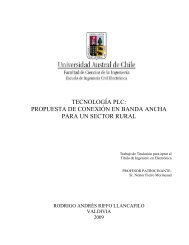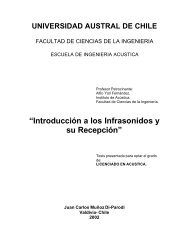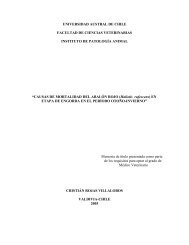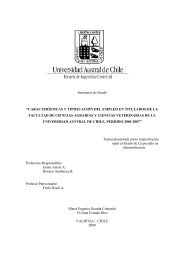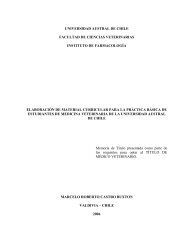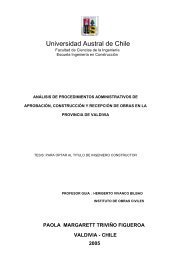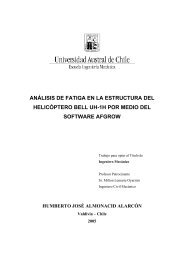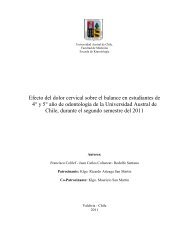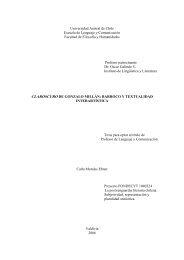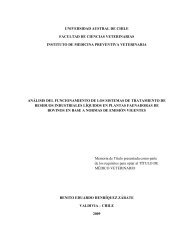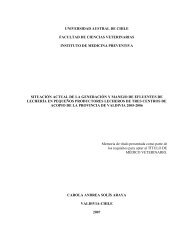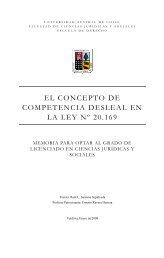Diversidad y control biológico de insectos - CyberTesis UACh ...
Diversidad y control biológico de insectos - CyberTesis UACh ...
Diversidad y control biológico de insectos - CyberTesis UACh ...
You also want an ePaper? Increase the reach of your titles
YUMPU automatically turns print PDFs into web optimized ePapers that Google loves.
Spore persistence in soil. Six-eight soil cores (9 cm diameter, 10 cm high) were extracted<br />
at random in each plot. They were pooled on a plastic bag to get ca. 1-1.5 k of soil and<br />
cooled (5-10° C) prior to analysis. Spores number was estimated through dilution plating<br />
method <strong>de</strong>scribed in <strong>de</strong>tail by Chase et al., 1986. We used dodine fomulated as Syllit 65<br />
WP (ANASAC, Santiago, Chile). The procedure was as follows:<br />
In the laboratory, the soil was sieved and litter and plant parts were removed. Fifteen grams<br />
of fresh soil were ad<strong>de</strong>d to a flask with 25 mL of sterilized distilled water and drops of<br />
Tween-20 as surfactant. In parallel, three samples of 100 g of soil were dried in a stove to<br />
measure the soil water content. The mix was shaken by hand for 5 min. An aliquot (2.5 mL)<br />
was transferred to a second tube and then sterilized water and Tween-20 were ad<strong>de</strong>d to<br />
complete 25 mL. The new tube was treated as above and when all the dilutions were<br />
available (10 -1 to 10 -3 ), we transferred 150 µL of suspension, using a pipette, to each plate<br />
with selective media (3 plates per dilution). The plates were cultivated for ten days (no<br />
light, 20° C) and colony forming units (CFU) were recor<strong>de</strong>d at the end of this period. A<br />
proportion of the colonies was sampled and correct i<strong>de</strong>ntification was confirmed by<br />
microscopic exam. Counts were corrected by water content to express the spore numbers on<br />
a dry soil basis. Spore number in soil was estimated five times in the study: before and 1, 5,<br />
15 and 66 days after spraying.<br />
Persistence of spores on leaves. Foliage samples were collected at random in each plot<br />
(10-15 points) and pooled. In the laboratory, pieces of foliage were cut with scissors and<br />
measured to complete 32 cm 2 . Leaf pieces were ad<strong>de</strong>d to a tube with 25 mL of sterilized<br />
distilled water and drops of Tween-20. Then, the same procedure of soil samples was<br />
adopted. Spore numbers are expressed by fresh leaf area. Just ryegrass leaves were inclu<strong>de</strong>d<br />
in this analysis. Sampling was performed at 1, 4 and 7 days after spraying.<br />
The dilution/transference process was repeated 4 times, therefore dilutions from 10 -1 to 10 -3<br />
were available, both soil and foliage samples. Estimates from dilution 10 -2 were used to<br />
draw Figure 1.<br />
Arthropod i<strong>de</strong>ntification.<br />
Specimens were stored on 70% ethanol. Samples were sorted in the laboratory with the aid<br />
of a microscope and i<strong>de</strong>ntification was performed with reference to Artigas (1994), CSIRO<br />
(1991) and with the help of a reference collection i<strong>de</strong>ntified by Dr. Roberto Carrillo<br />
79



